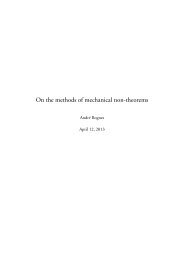The passive voice in written and spoken Scandinavian
The passive voice in written and spoken Scandinavian
The passive voice in written and spoken Scandinavian
Create successful ePaper yourself
Turn your PDF publications into a flip-book with our unique Google optimized e-Paper software.
(c) der skulle jo sikkert også skrælles mange kartofler ~ ja vi var jo syv børn<br />
‘probably there needed to be peeled a lot of potatoes ~ you see, we were seven<br />
children’<br />
In addition to the previous examples there are also examples with other mean<strong>in</strong>gs of<br />
the construction (skal + morphological <strong>passive</strong>) available <strong>in</strong> Danish. Consider the<br />
follow<strong>in</strong>g examples <strong>in</strong> (15a, b).<br />
(15) (a) alle havde virkelig sat sig op til ~ nu skal der altså bare fejres jubilæum ik<br />
‘everybody had really prepared themselves ~ now we were really ready to<br />
celebrate the jubilee’<br />
(b) han skulle giftes ~ og så ~ altså anede jeg ikke hvor hvor det skulle holdes<br />
men lige pludselig så blev det sagt til morgenbordet<br />
‘he is go<strong>in</strong>g to marry ~ <strong>and</strong> then ~ well, I did not know where it would take<br />
place but all of a sudden it was mentioned at the breakfast table’<br />
<strong>The</strong> first example (15a) is neither an obligation nor an <strong>in</strong>struction to celebrate the<br />
jubilee. It is rather a prospective plan (or wish) of the people (alle, ‘everybody’) who<br />
have made themselves ready for the event. <strong>The</strong> second example, (15b), <strong>in</strong> the<br />
preterite tense, should be <strong>in</strong>terpreted as the speaker be<strong>in</strong>g unaware of where the<br />
wedd<strong>in</strong>g will take place.<br />
Accord<strong>in</strong>g to our corpus data, these two read<strong>in</strong>gs both seem to be productive<br />
<strong>in</strong> Danish. A more extensive <strong>in</strong>vestigation of the <strong>spoken</strong> language data is needed, but<br />
it is likely that there is considerable variation <strong>in</strong> the use <strong>and</strong> mean<strong>in</strong>g of Danish<br />
modal <strong>passive</strong>s (as also suggested by Br<strong>and</strong>t (1999)).<br />
4 Conclud<strong>in</strong>g remarks<br />
<strong>The</strong> analysis has po<strong>in</strong>ted to both similarities <strong>and</strong> differences <strong>in</strong> the use of the <strong>passive</strong><br />
<strong>voice</strong> <strong>in</strong> the three Sc<strong>and</strong><strong>in</strong>avian languages. <strong>The</strong> differences <strong>and</strong> similarities are found<br />
both across the languages <strong>and</strong> across the <strong>spoken</strong> <strong>and</strong> <strong>written</strong> register. <strong>The</strong> largest<br />
26

















